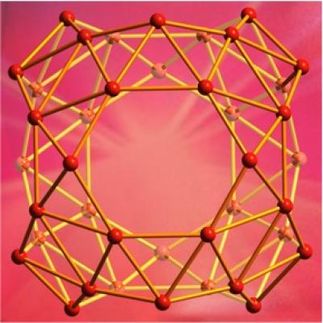The art of molecular carpet-weaving
2-D networks from boron acids
Even the costliest oriental carpets have small mistakes. It is said that pious carpet-weavers deliberately include tiny mistakes in their fine carpets, because only God has the right to be immaculate. Molecular carpets, as the nanotechnology industry would like to have them are as yet in no danger of offending the gods. A team of physicists headed by Dr. Markus Lackinger from the Technische Universität München (TUM) und Professor Thomas Bein from the Ludwig-Maximilians-Universität München (LMU) has now developed a process by which they can build up high-quality polymer networks using boron acid components.
The "carpets" that the physicists are working on in their laboratory in the Deutsches Museum München consist of ordered two-dimensional structures created by self-organized boron acid molecules on a graphite surface. By eliminating water, the molecules bond together in a one-atom thick network held together solely by chemical bonds – a fact that makes this network very stable. The regular honey-comb-like arrangement of the molecules results in a nano-structured surface whose pores can be used, for instance, as stable forms for the production of metal nano-particles.
The molecular carpets also come in nearly perfect models; however, these are not very stable, unfortunately. In these models the bonds between the molecules are very weak – for instance hydrogen bridge bonds or van der Waals forces. The advantage of this variant is that faults in the regular structure are repaired during the self-organization process – bad bonds are dissolved so that proper bonds can form.
However, many applications call for molecular networks that are mechanically, thermally and/or chemically stable. Linking the molecules by means of strong chemical bonds can create such durable molecule carpets. The down side is that the unavoidable weaving mistakes can no longer be corrected due to the great bonding strength.
Markus Lackinger and his colleagues have now found a way to create a molecular carpet with stable covalent bonds without significant weaving mistakes. The method is based on a bonding reaction that creates a molecular carpet out of individual boron acid molecules. It is a condensation reaction in which water molecules are released. If bonding takes place at temperatures of a little over 100°C with only a small amount of water present, mistakes can be corrected during weaving. The result is the sought after magic carpet: molecules in a stable and well-ordered one-layer structure.
Original publication
J F Dienstmaier, A M Gigler, A J Goetz, P Knochel, T Bein, A Lyapin, S Reichlmaier, W M Heckl, M Lackinger; "Synthesis of well-ordered COF monolayers: Surface growth of nanocrystalline precursors versus direct on-surface polycondensation"; ACS Nano Vol. 5, 12, 9737-9745.
Original publication
J F Dienstmaier, A M Gigler, A J Goetz, P Knochel, T Bein, A Lyapin, S Reichlmaier, W M Heckl, M Lackinger; "Synthesis of well-ordered COF monolayers: Surface growth of nanocrystalline precursors versus direct on-surface polycondensation"; ACS Nano Vol. 5, 12, 9737-9745.
Organizations
Other news from the department science

Get the chemical industry in your inbox
By submitting this form you agree that LUMITOS AG will send you the newsletter(s) selected above by email. Your data will not be passed on to third parties. Your data will be stored and processed in accordance with our data protection regulations. LUMITOS may contact you by email for the purpose of advertising or market and opinion surveys. You can revoke your consent at any time without giving reasons to LUMITOS AG, Ernst-Augustin-Str. 2, 12489 Berlin, Germany or by e-mail at revoke@lumitos.com with effect for the future. In addition, each email contains a link to unsubscribe from the corresponding newsletter.



























































